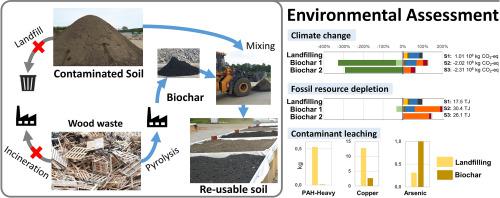Science of the Total Environment ( IF 8.2 ) Pub Date : 2021-02-18 , DOI: 10.1016/j.scitotenv.2021.145953 Asterios Papageorgiou , Elias S. Azzi , Anja Enell , Cecilia Sundberg

|
The use of biochar to stabilize soil contaminants is emerging as a technique for remediation of contaminated soils. In this study, an environmental assessment of systems where biochar produced from wood waste with energy recovery is used for remediation of soils contaminated with polycyclic aromatic hydrocarbons (PAH) and metal(loid)s was performed. Two soil remediation options with biochar (on- and off-site) are considered and compared to landfilling. The assessment combined material and energy flow analysis (MEFA), life cycle assessment (LCA), and substance flow analysis (SFA). The MEFA indicated that on-site remediation can save fuel and backfill material compared to off-site remediation and landfilling. However, the net energy production by pyrolysis of wood waste for biochar production is 38% lower than incineration. The LCA showed that both on-site and off-site remediation with biochar performed better than landfilling in 10 of the 12 environmental impact categories, with on-site remediation performing best. Remediation with biochar provided substantial reductions in climate change impact in the studied context, owing to biochar carbon sequestration being up to 4.5 times larger than direct greenhouse gas emissions from the systems. The two biochar systems showed increased impacts only in ionizing radiation and fossils because of increased electricity consumption for biochar production. They also resulted in increased biomass demand to maintain energy production. The SFA indicated that leaching of PAH from the remediated soil was lower than from landfilled soil. For metal(loid)s, no straightforward conclusion could be made, as biochar had different effects on their leaching and for some elements the results were sensitive to water infiltration assumptions. Hence, the reuse of biocharremediated soils requires further evaluation, with site-specific information. Overall, in Sweden's current context, the biochar remediation technique is an environmentally promising alternative to landfilling worth investigating further.
中文翻译:

瑞典从木材废料产生的用于土壤修复的生物炭:固碳和其他环境影响
使用生物炭稳定土壤污染物是一种用于修复污染土壤的技术。在这项研究中,对系统进行了环境评估,在该系统中,利用废木料产生的生物炭进行了能量回收,以修复被多环芳烃(PAH)和金属(金属)污染的土壤。考虑了两种使用生物炭进行土壤修复的方法(现场和异地),并将其与垃圾填埋场进行比较。该评估结合了物质和能量流分析(MEFA),生命周期评估(LCA)和物质流分析(SFA)。MEFA指出,与非现场修复和填埋相比,现场修复可节省燃料和回填材料。但是,通过热解木材废物来生产生物炭而产生的净能量比焚烧要低38%。LCA显示,在12种环境影响类别中的10种中,使用生物炭进行的现场和异地修复均优于填埋,其中现场修复的效果最佳。在研究的范围内,由于生物炭的固碳量是系统直接温室气体排放量的4.5倍之多,因此在研究的背景下,用生物炭进行的修复大大降低了气候变化影响。由于增加了生物炭生产的电力消耗,这两种生物炭系统仅在电离辐射和化石中显示出更大的影响。它们还导致增加的生物质需求以维持能源生产。SFA指出,从修复土壤中浸出的PAH低于从垃圾填埋土壤中浸出的PAH。对于金属(类),无法直接得出结论,由于生物炭对其浸出的影响不同,并且对于某些元素,结果对水的渗透假设很敏感。因此,生物炭介导的土壤的再利用需要根据具体地点的信息进行进一步评估。总体而言,在瑞典当前的背景下,生物炭修复技术是一种值得在环保方面替代填埋的有前途的替代方法,值得进一步研究。











































 京公网安备 11010802027423号
京公网安备 11010802027423号